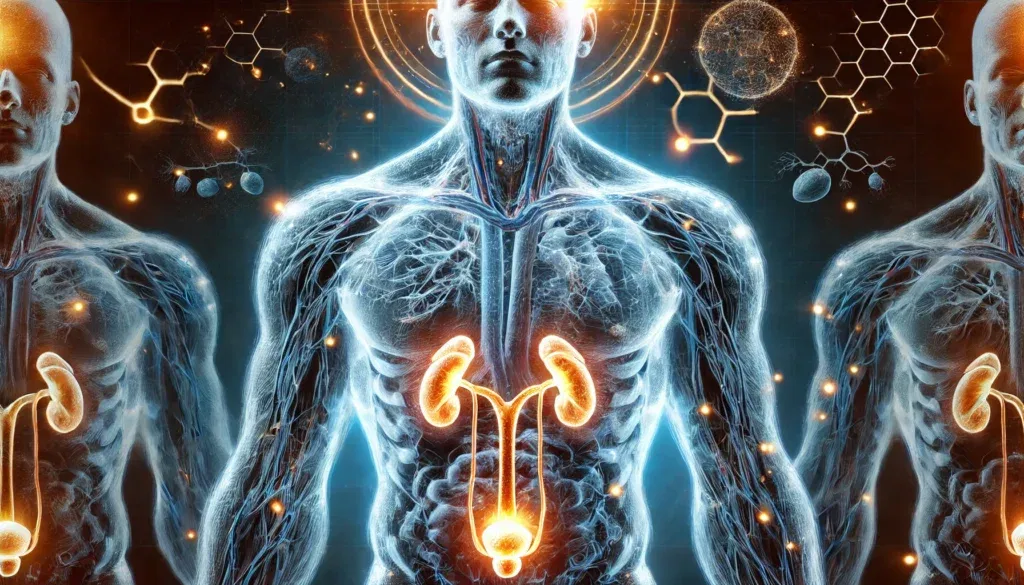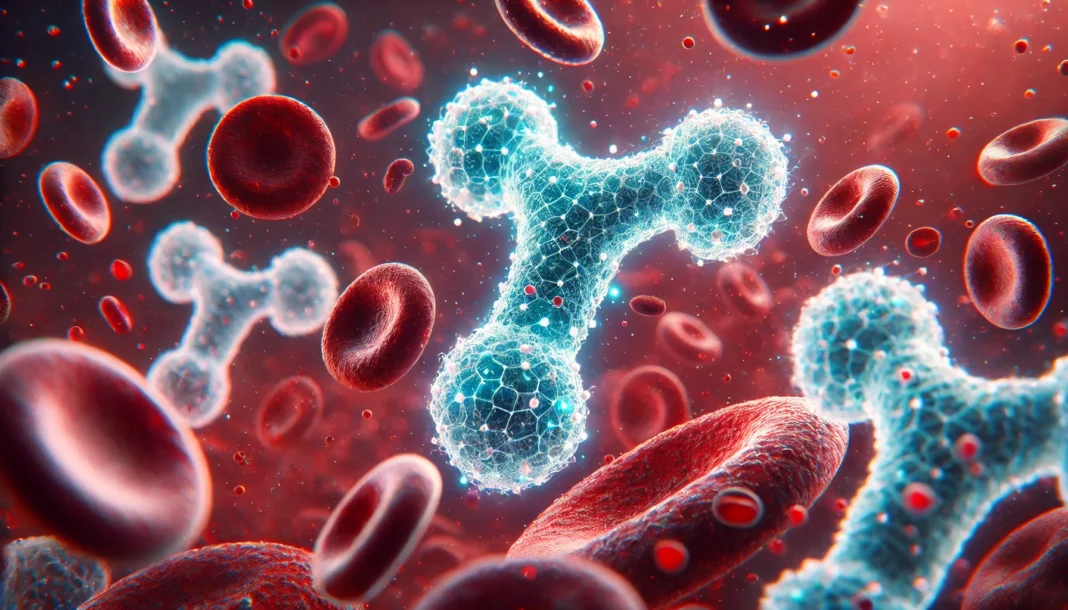Testosterone is a crucial hormone in the human body, playing a fundamental role in numerous physiological functions, particularly in men. It influences muscle mass, bone density, red blood cell production, and overall vitality. However, not all testosterone in the body is biologically active; much of it is bound to proteins like sex hormone-binding globulin (SHBG) and albumin, leaving only a small fraction as “free testosterone.” Understanding free testosterone levels is essential for assessing hormonal balance and overall health. This guide explores how to calculate testosterone levels accurately, delves into the free testosterone calculation formula, and provides essential insights into its clinical relevance.
You may also like: How to Get Your Testosterone Levels Checked: Best At-Home and Lab Testing Options
Understanding the Importance of Testosterone and Its Forms
Testosterone exists in the bloodstream in three primary forms: free testosterone, albumin-bound testosterone, and SHBG-bound testosterone. The SHBG-bound fraction is biologically inactive and tightly bound to its carrier protein, rendering it unavailable for direct cellular action. Albumin-bound testosterone is weakly bound and can dissociate in circulation, making it bioavailable. Free testosterone, which constitutes only about 1-3% of total testosterone, is the most active form since it is readily available to bind to androgen receptors and exert physiological effects.
Total testosterone measurement alone does not provide a complete picture of an individual’s androgenic status. Since SHBG levels can vary significantly due to age, obesity, thyroid dysfunction, liver disease, and other factors, relying solely on total testosterone may be misleading. This is why calculating free testosterone is vital for accurate hormonal assessment.

Methods for Measuring Testosterone Levels
There are several methods to measure testosterone levels, each with distinct advantages and limitations. The most common approaches include direct measurement of total testosterone via immunoassays or liquid chromatography-tandem mass spectrometry (LC-MS/MS). Free testosterone can be assessed using equilibrium dialysis, ultrafiltration, or calculated through validated mathematical formulas.
Direct measurement of free testosterone, particularly via equilibrium dialysis, is considered the gold standard due to its accuracy. However, it is expensive, time-consuming, and not widely available in clinical settings. Consequently, calculated free testosterone provides a practical and cost-effective alternative that correlates well with equilibrium dialysis results.
The Free Testosterone Calculation Formula
One widely accepted method for estimating free testosterone is the Vermeulen equation. This formula uses total testosterone, SHBG, and albumin levels to calculate free testosterone accurately. The equation is as follows:
FT=Ttotal×(1+Ka×[albumin])1+Ka×[albumin]+Kb×[SHBG]FT = \frac{T_{total} \times (1 + K_{a} \times [albumin])}{1 + K_{a} \times [albumin] + K_{b} \times [SHBG]}
Where:
- FT represents free testosterone in nmol/L.
- Ttotal is total testosterone in nmol/L.
- SHBG is sex hormone-binding globulin in nmol/L.
- Albumin is measured in g/L (typically assumed to be 43 g/L if not measured).
- Ka is the albumin binding constant (usually 3.6 x 10^4 L/mol).
- Kb is the SHBG binding constant (typically 1 x 10^9 L/mol).
This formula enables clinicians and researchers to estimate free testosterone accurately without requiring direct measurement, making it an invaluable tool for assessing androgen status.
Factors Affecting Free Testosterone Levels
Several physiological and pathological factors can influence free testosterone levels. Age is a significant determinant, as testosterone levels naturally decline with aging. Obesity and metabolic syndrome also contribute to lower free testosterone due to increased SHBG and aromatization of testosterone into estrogen in adipose tissue. Liver and thyroid function play crucial roles as well, given their regulatory influence on SHBG synthesis. Chronic illnesses, medications such as corticosteroids or opioids, and lifestyle factors like diet and exercise can further impact testosterone metabolism.
Understanding these variables is essential when interpreting calculated free testosterone levels, as adjustments may be needed based on individual health conditions.
Clinical Significance of Free Testosterone Calculation
Accurate assessment of free testosterone is critical for diagnosing and managing various medical conditions. In men, low free testosterone can manifest as fatigue, reduced libido, erectile dysfunction, depression, loss of muscle mass, and osteoporosis. In women, abnormal testosterone levels can lead to conditions such as polycystic ovary syndrome (PCOS), hirsutism, and infertility.
Men presenting with symptoms of testosterone deficiency but having total testosterone within the normal range should undergo free testosterone calculation for a more comprehensive evaluation. Conversely, individuals with symptoms of androgen excess should also be assessed to determine whether high free testosterone levels are contributing to their clinical presentation.
Improving Testosterone Levels Naturally
For individuals seeking to optimize testosterone levels, lifestyle modifications can play a significant role. Regular strength training, adequate sleep, and stress management help maintain healthy testosterone production. A balanced diet rich in healthy fats, proteins, and micronutrients such as zinc and vitamin D supports endocrine function. Avoiding excessive alcohol consumption, processed foods, and environmental toxins can further aid in maintaining hormonal balance.
Medical interventions such as testosterone replacement therapy (TRT) may be considered for individuals with clinically low free testosterone levels. However, TRT should always be prescribed under medical supervision, as inappropriate use can lead to adverse effects, including cardiovascular risks, infertility, and erythrocytosis.

Frequently Asked Questions (FAQ) on Free Testosterone Calculation
1. Why is free testosterone calculation important for assessing hormonal health?
Free testosterone calculation is crucial because it determines the active form of testosterone available for biological functions. Total testosterone levels alone do not provide a complete picture, as a significant portion binds to proteins such as sex hormone-binding globulin (SHBG) and albumin, making it unavailable for use. By using a free testosterone calculation formula, individuals can better understand their true androgenic potential, which impacts muscle growth, libido, mood, and overall vitality. Additionally, conditions such as hypogonadism, metabolic disorders, and aging-related hormonal decline can be more accurately diagnosed and managed with this method. Understanding how to calculate testosterone levels correctly helps healthcare providers make precise treatment decisions.
2. How does SHBG affect free testosterone levels?
Sex hormone-binding globulin (SHBG) plays a significant role in regulating free testosterone levels by binding to testosterone and reducing its bioavailability. When SHBG levels are high, less testosterone remains free, potentially leading to symptoms of testosterone deficiency despite normal total testosterone readings. Conversely, low SHBG levels can result in higher free testosterone, sometimes leading to symptoms such as acne or mood instability. Free testosterone calculation formulas take SHBG into account, offering a more nuanced evaluation of an individual’s hormonal balance. Those with conditions like obesity, liver disease, or thyroid disorders often experience fluctuating SHBG levels, making accurate testosterone assessment critical for treatment.
3. What is the most accurate free testosterone calculation formula?
Several formulas exist for calculating free testosterone, but the Vermeulen equation is widely regarded as one of the most accurate. This formula considers total testosterone, SHBG, and albumin levels to estimate the biologically active fraction of testosterone. Other methods, such as the equilibrium dialysis and mass spectrometry techniques, provide direct measurements but are costly and not always practical for routine clinical use. By applying a reliable free testosterone calculation formula, individuals can obtain precise insights into their androgen status without requiring expensive lab tests. Online calculators that use validated equations help streamline the process for both patients and healthcare professionals.
4. How can I calculate testosterone levels at home?
While at-home testosterone test kits provide an estimate of total testosterone, they often lack the complexity needed for a full free testosterone calculation. However, individuals can still calculate testosterone levels manually by using an online free testosterone calculation formula that includes SHBG and albumin. This requires recent lab results, as measuring SHBG and albumin is essential for accuracy. Some home test kits are improving in quality, but for the most precise free testosterone calculation, consulting a medical professional remains advisable. Understanding how to interpret test results and track trends over time can help individuals make informed health decisions.
5. Can lifestyle changes influence free testosterone levels?
Yes, lifestyle changes can significantly impact free testosterone levels by influencing SHBG and overall hormone production. Regular strength training and high-intensity interval workouts have been shown to boost testosterone naturally. A diet rich in healthy fats, including omega-3 fatty acids and monounsaturated fats, supports hormonal balance. Reducing stress through meditation and improving sleep quality can also enhance free testosterone production. Since these factors can alter SHBG levels, incorporating them into daily habits may positively influence testosterone balance, reducing the need for medical intervention in some cases.
6. Why do some people have normal total testosterone but low free testosterone?
This discrepancy often occurs due to elevated SHBG levels, which bind to testosterone and reduce its availability. Factors such as aging, certain medications (e.g., statins and birth control pills), and metabolic conditions can increase SHBG, leading to lower free testosterone levels. Free testosterone calculation helps clarify this situation by revealing whether the biologically active hormone is deficient despite normal total testosterone readings. Addressing underlying causes, such as optimizing thyroid function or adjusting medication, can help restore a healthier balance. Without a proper free testosterone calculation, many cases of androgen deficiency might go undiagnosed.
7. Can free testosterone calculation help diagnose hypogonadism?
Yes, free testosterone calculation is essential in diagnosing hypogonadism, a condition characterized by inadequate testosterone production. Many clinicians rely on total testosterone alone, which can lead to misdiagnosis due to the variability of SHBG levels. A free testosterone calculation formula provides a clearer picture of hormone availability and helps determine whether symptoms such as fatigue, depression, and reduced libido stem from true testosterone deficiency. Accurate diagnosis allows for tailored treatments, such as testosterone replacement therapy (TRT) or lifestyle modifications, to improve hormonal health.
8. How does aging affect free testosterone levels?
As men age, total testosterone levels gradually decline, but SHBG levels often increase, further reducing free testosterone availability. This can lead to symptoms of androgen deficiency, including loss of muscle mass, cognitive decline, and sexual dysfunction. Free testosterone calculation is particularly valuable for older individuals to differentiate between normal aging and clinically significant testosterone deficiency. Hormone replacement therapy, when medically necessary, can help mitigate these effects and improve quality of life. Understanding how to calculate testosterone accurately becomes increasingly important with age to manage symptoms effectively.
9. Are there any medical conditions that can skew free testosterone calculations?
Several medical conditions can alter SHBG and albumin levels, which in turn affect free testosterone calculation results. Liver disease, hyperthyroidism, and chronic illnesses like kidney disease can increase SHBG, leading to falsely low free testosterone readings. Conversely, insulin resistance and obesity often decrease SHBG, potentially overestimating free testosterone availability. This highlights the importance of considering overall health status when interpreting testosterone levels. Physicians must carefully analyze lab results in conjunction with symptoms to ensure accurate diagnosis and treatment.
10. Should women also monitor their free testosterone levels?
Yes, although testosterone is often associated with men’s health, it plays a crucial role in women’s well-being as well. Free testosterone calculation helps assess conditions like polycystic ovary syndrome (PCOS), adrenal disorders, and unexplained fatigue or libido issues in women. While women naturally have lower testosterone levels than men, an imbalance—either too high or too low—can lead to significant health problems. Using a free testosterone calculation formula tailored for female physiology provides better diagnostic insights. Healthcare providers can then recommend appropriate treatments, such as lifestyle changes, hormonal therapy, or targeted medications to optimize hormonal balance.

Conclusion: The Importance of Accurate Free Testosterone Calculation
Understanding and accurately calculating testosterone levels is crucial for both clinical assessment and personal health management. Given the limitations of total testosterone measurement, free testosterone calculation provides a clearer picture of androgen activity in the body. Using validated formulas, such as the Vermeulen equation, allows healthcare professionals and individuals to assess hormonal balance effectively.
Recognizing the factors that influence testosterone levels, interpreting laboratory results appropriately, and taking steps to maintain optimal testosterone levels can significantly impact overall health and well-being. Whether through natural lifestyle changes or medical interventions, maintaining balanced testosterone levels is essential for longevity and vitality. By utilizing the free testosterone calculation formula, individuals can gain deeper insights into their hormonal status and make informed decisions regarding their health.
testosterone measurement methods, hormone health analysis, free testosterone estimation, SHBG and testosterone, androgen level testing, testosterone deficiency symptoms, total vs free testosterone, calculating free testosterone, endocrine function assessment, hormone balance optimization, men’s health testosterone, natural testosterone boosters, hormone level testing accuracy, SHBG effects on testosterone, testosterone replacement therapy, age-related testosterone decline, testosterone metabolism, clinical hormone evaluation, optimizing male health, androgen deficiency diagnosis
Further Reading:
Accurate measurement of total and free testosterone levels for the diagnosis of androgen disorders
Accuracy of calculated free testosterone formulae in men
Disclaimer: The information provided in this article is for general informational purposes only. The content does not constitute professional advice of any kind, including but not limited to medical, legal, or financial advice. HisHealthMag and its contributors make no representations or warranties regarding the accuracy, completeness, or reliability of the information presented. Always seek the advice of a qualified professional for any specific concerns or questions you may have. Neither HisHealthMag nor its authors assume any responsibility or liability for any actions taken based on the information provided in this article. The views and opinions expressed are those of the author(s) and do not necessarily reflect the official policy or position of HisHealthMag.





